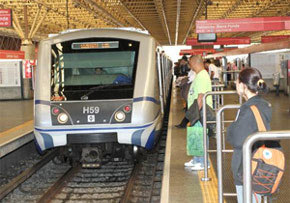

Savings result from the greater mobility of workers and subsequent increase in productivity
Savings result from the greater mobility of workers and subsequent increase in productivity.
Savings result from the greater mobility of workers and subsequent increase in productivity.

Savings result from the greater mobility of workers and subsequent increase in productivity
By José Tadeu Arantes
Agência FAPESP – In addition to facilitating the life of its people, the metro could make a major contribution to the economy. If São Paulo did not have a subway, for example, the Brazilian economy would lose R$ 19.3 billion per year. This value corresponds to two thirds of the cost of the construction of the entire subway system in the city. If these savings were invested in the metro system, it would be possible to double the metro system in just a year and a half.
That is the conclusion of a study entitled “The Underground Economy: Tracking the Wider Impacts of the São Paulo Subway System,” coordinated by Eduardo Amaral Haddad, full professor in the Department of Economics of the School of Economics and Accounting at the Universidade de São Paulo (FEA-USP).
The econometric study was funded by FAPESP and the National Council of Scientific and Technological Development (CNPq) under the auspices of the National Science and Technology Institute on Climate Change (INCT Clima).
The main topics and related themes of the study were presented at a workshop that was held at FEA-USP on June 7 and was open to the public.
“The subway serves 4 million passengers daily. Seventy percent of the trips are workers going to work and returning to their residences. The faster travel time afforded by the metro contributes directly to increased productivity among these workers, and as a result, to improved economic performance at the firms where they are employed,” commented Haddad in an interview with Agência FAPESP.
To quantify the economic impact of the São Paulo metro system, the researcher utilized the concept of the “effective size of the labor market.” This is defined as the number of jobs that a worker can reach within a defined period of time, based on his or her residence.
The greater the “effective labor market” is, the greater the number of job offers for any given worker and the greater the availability of work in firms that can be reached in the defined interval of time.
“Larger and denser markets tend to pay better salaries because of the competition between firms. It is what we call an ‘agglomeration economy.’ And the size and density of the market depends, obviously, on the transport infrastructure, among other factors. These were the principles that guided our collection of microdata, which are later integrated into the system as a whole, “explained Haddad.
The researchers conducted a simulation in which they eliminated the metro to assess its economic influence. The calculations showed that the municipal gross domestic product (GDP) would be 1.7% lower without the metro and that the national GDP would be 0.6% lower. The R$ 19.3 billion figure is derived from those calculations.
“We also simulated a situation in which the metro was replaced by another high-efficiency alternative, the Bus Rapid Transit (BRT), in which articulated or bi-articulated buses travel at high speed in dedicated lanes. It is a transportation system like the one implemented in Curitiba at the end of the 1970s. In the same case, the simulation showed that the metro is a better option, presenting annual savings of R$ 6.4 billion, compared to BRT,” explains Haddad.
Other advantages
Haddad stresses that the study was focused solely on the economic impact associated with the productivity of workers, who are influenced by mobility, that is, by the average time spent on travel from home to work. Another advantage is the reduction in emission of atmospheric pollutants, a factor that should also be considered for a global evaluation.
The São Paulo metro system currently stretches 74.3 kilometers across five lines and has 64 stations.
“This system has become indispensible both for transportation of São Paulo residents and for a significant number of the 1 million workers that flood into the city daily from other municipalities. The regions that most attract these workers are Downtown (180,000) and Western São Paulo (300,000), both of which are partially served by the metro,” according to Haddad.
The São Paulo metro is the third longest in Latin America, behind not only that of Mexico City but also that of Santiago (Chile), whose population is half that of São Paulo. Meanwhile, the streets and avenues of the city are seeing more and more traffic on a day-to-day basis, stalled by a fleet of vehicles that reached 7,429,805 in number in April 2013.
Republish
The Agency FAPESP licenses news via Creative Commons (CC-BY-NC-ND) so that they can be republished free of charge and in a simple way by other digital or printed vehicles. Agência FAPESP must be credited as the source of the content being republished and the name of the reporter (if any) must be attributed. Using the HMTL button below allows compliance with these rules, detailed in Digital Republishing Policy FAPESP.





